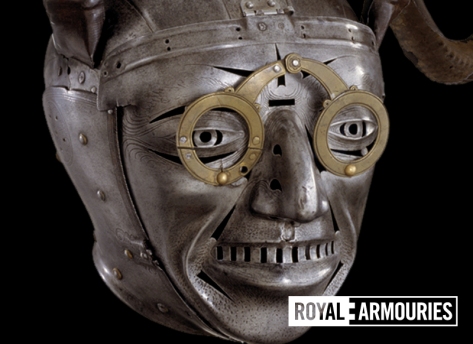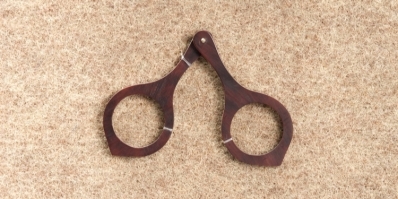I Can See You More Clearly Through the Glass
than Through the Air
So you costume in the Renaissance, but without your glasses, everything looks like you’re riding a runaway Tilt-a-Whirl. Congratulations! You and Henry VIII have something in common!

I do not know if that’s a compliment or not…
Besides being one of the most famous divorcees of all time, Henry VIII was exceptionally near-sighted. This is a problem for a king who likes to engage in numerous outdoor activities like archery or in Henry’s case, jousting. In fact, Henry VIII received this helmet as a gift from Holy Roman Emperor Maximilian I in 1514:
The Horned Helmet of Henry VIII, circa 1514
It is not exactly the most flattering helmet (in fact, many believe it was worn by the court fool, Will Somers), but it’s fascinating for one fact: the golden hinged glasses perched on the prominent nose. Whether this was good ol’ Max poking some major fun at Henry’s well-known nearsightedness, or just a portrait of the king, we may never know. If you watch the video, you can see that in motion, the helmet is actually quite impressive looking. Though Henry’s opponents might have giggled behind their hands while Henry wasn’t looking, imaging seeing this glinting, silver face rocking towards you above a charging warhorse.
The helmet’s eyeglasses look decorative and not functional, but eyeglasses of this hinged type had been in use for over 200 years before this helmet was made and magnifiers made from crystal had been in use since ancient times. Fuzzy eyesight is nothing new, especially considering how much electric lights have improved out viewing environment. We no longer have to squint at embroidery or manuscripts by the meager light of a candle past dark, but we do wear our eyes out squinting at luminescent screens. Medieval glasses did not have temple-to-ear stems as ours do. They consisted of two round lenses held in bone, horn, leather, or metal frames that were hinged in the center like a fan.
 “Wildunger Altar” Detail by Conrad von Soest, circa 1403
“Wildunger Altar” Detail by Conrad von Soest, circa 1403
The BOA Museum’s replica of spectacles from around 1350
Bone Eyeglass Frames, circa 1400-1500
They pinched onto the nose or were held to the face like a 19th century pair of opera glasses. Some enterprising eyeglass wearers tied strings around their ears to hold their spectacles in place:
Luis de Velasco II, Marqués de Salinas, circa 1607
Glasses became quite widespread during the 15th and 16th centuries. Bone frames were made from the leg bones of oxen, which were wide enough to allow a frame to be cut in one piece. Leather frames made for a lightweight pair of spectacles at a low price. If the leather frame wore out, the lenses could be put into a new frame inexpensively and without too much trouble at the local spectacle merchant’s shop.
“The Ill-Matched Lovers” from the studio of Jacob Cornelisz van Oostsanen, late 15th century
Northern Europeans always enjoyed a good comical paintings with a touch of scandal. This work is no exception. While the young lady and older gentleman look at a selection of eyeglasses (ironically, of course!), the young husband and elderly wife get a little too cuddly in the background and he’s even so bold as to reach right into the money pot! Obviously the elderly man needs those spectacles quite badly. This was a popular motif, but what’s really fascinating is the box of glasses at hand. We do not think of spectacles as medieval/renaissance nor commonplace, yet here is a painting showing a good lot of eyeglasses ready for purchasing.
Eyeglasses with stems to sit on the ear were invented in the 18th century, but the simple, round-lens style without earstems remained popular into the early part 19th century until they evolved into reading glasses that hung from a chain pinned to the lapel, becoming the Victorian pince nez glasses we know and love.
Spectacles and Carved Wood Case, circa 17th century
Spectacles and Mother of Pearl Case, circa 1685-1725
Another English king, James II, was rumored to have owned this fine pair of folding spectacles.

Pince Nez Glasses, circa 1900
More historical glasses info:
“The Pince Nez Guide” – Multiple styles by date
“Eyeglasses and Spectacles from the Middle Ages to the Renaissance” on Larsdatter – Super fantastic database from everything medieval and renaissance!
“Chart of Heymann Collection Discovered at the Musée National de la Renaissance (The Eyeglass Cases, Part 1)” – Also, check out part 2!
“How to Make Medieval Eyeglasses” – If you know how to weld, this guide tells you how to use an old pair of your own glasses to make a more period-correct pair. Eliminate the ear wires for 14th-17th century glasses.
“Rivet Spectacles: The Earliest Style” – Lots of information on Medieval eyeglasses including a wonderful chart of known examples.
Recreation of Medieval Hinged Eyeglasses, made 2008
Made with wood, rivet, and twine with round glass lenses
As with all my articles, all of the images in this article are either linked to larger versions, articles explaining them, or other fact-filled sites to help you explore, so please feel free to check them out!









